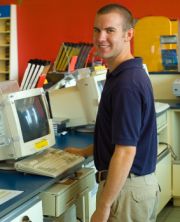Secure This
by in Feature Articles on 2007-10-30It's common knowledge that a security system is only as effective as its weakest point. You can install a reinforced steel door with a two-phase palm-print/retinal-scan entry to protect your home, but if you leave a first-floor window open, you're more vulnerable than your neighbor with a simple deadbolt. One of Nate's clients learned this lesson first hand with its e-commerce Web site. The operation didn't involve terribly sensitive data: there were no bank accounts, no Social Security numbers, nor even any credit card numbers. Pre-approved customers would simply sign in and place their orders. Accounts payable and fulfillment would take it from there.
Yet the Web site painted a different picture, featuring two-factor authentication, encrypted databases and a giant padlock graphic advertising "secure."

 Sep 07
Sep 07 "Hey, don't take another step!" Chris H. froze in his tracks. The voice cried out "we're dead in the water here!"
"Hey, don't take another step!" Chris H. froze in his tracks. The voice cried out "we're dead in the water here!" Many years back, Vinay's company phased out Form 11.18-B, or, as it was more commonly known, the vacation request form. Along with it went Form 11.18-M (sick day request form), Form 11.12-B (absence cancellation form) and Form 12.11-B (absence exceed form). They were all rolled into the new Absence Processing System (APS) as part of the company's Process Improvement Process, a far-reaching initiative to technologize all things bureaucratic. Most employees didn't care for the new APS. Before going electronic, applying for vacation was simple: Have your manager sign Form 11.18-B, send the yellow copy to HR and keep the pink one. Using the APS meant opening up the application, trying to remember your APS password, clicking to the vacation request form, filling it out and then telling your manager to follow the same steps in order to approve it.
Many years back, Vinay's company phased out Form 11.18-B, or, as it was more commonly known, the vacation request form. Along with it went Form 11.18-M (sick day request form), Form 11.12-B (absence cancellation form) and Form 12.11-B (absence exceed form). They were all rolled into the new Absence Processing System (APS) as part of the company's Process Improvement Process, a far-reaching initiative to technologize all things bureaucratic. Most employees didn't care for the new APS. Before going electronic, applying for vacation was simple: Have your manager sign Form 11.18-B, send the yellow copy to HR and keep the pink one. Using the APS meant opening up the application, trying to remember your APS password, clicking to the vacation request form, filling it out and then telling your manager to follow the same steps in order to approve it.  Marcel is whiling away the days as IT support for a few regional libraries. Typically, this means that he has to answer questions like "is this keyboard unplugged?" and "why does the screen turn off when I press this button on the monitor?"
Marcel is whiling away the days as IT support for a few regional libraries. Typically, this means that he has to answer questions like "is this keyboard unplugged?" and "why does the screen turn off when I press this button on the monitor?" When Eric C. arrived at his new job, it was with a huge sense of relief. His old workplace had been a haven for cowboy coders and anarchic hackers, where the only semblance of consistency was in everyone's preference to modify code directly in production.
When Eric C. arrived at his new job, it was with a huge sense of relief. His old workplace had been a haven for cowboy coders and anarchic hackers, where the only semblance of consistency was in everyone's preference to modify code directly in production.